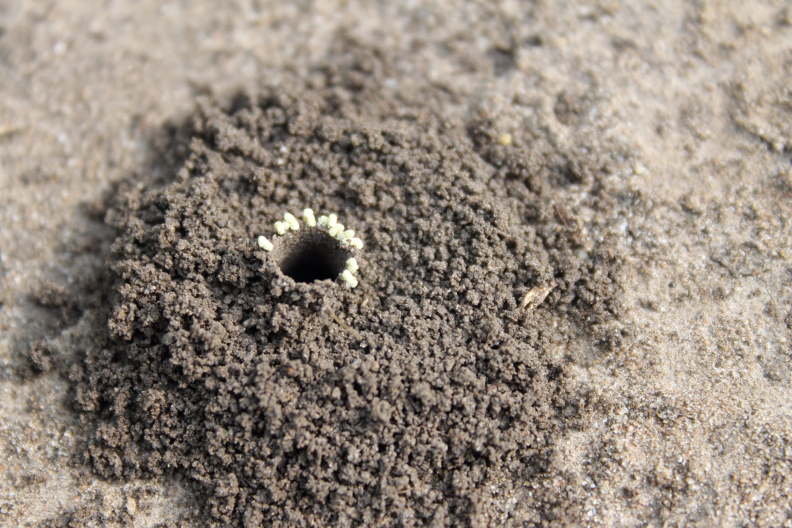
A nest turrent of Diadasia afflicta. The small white objects are fecal pellets placed around the next entrance for reasons know only to the bee (Photo by Larry Brennan).
Every now and then I learn about a new quirky insect so interesting that I have to pass it on. This week’s curiosity comes courtesy of Ken Steigman, entomologist and Director of the Lake Lewisville Environmental Learning Area in Lewisville, TX. Ken sent the accompanying image taken by a friend. What caught his eye were the distinct white pellets so neatly placed around the entrance to the mound.
According to Dr. John Neff, with the Central Texas Melittological Institute in Austin, the builder of this neat little nest is a solitary bee called Diadasia afflicta. This little gray and white bee is extremely fastidious in its scatological habits. According to Neff, D. afflicta forages almost exclusively on the pollen of winecups (Callirhoe species), a common spring wildflower seen along Texas roadsides. The bee not only feeds on the pollen, but the female collects pollen to pack into small, underground, urn-shaped cells to provide food for her offspring.

Wine cup, or Callirhoe, is a common Texas spring wildflower and the preferred pollen source for Diadasia.
It turns out that Callirhoe pollen is white, and so are the fecal droppings of the female bee. According to Neff, “Diadasia afflicta is unusual, perhaps unique, in regularly placing these pellets on the edge of the turret.” The bee places a series of pellets around the turrent each night, older nests sometimes showing a series of rings suggesting the age of the nest. There are other species of Diadasia that do not display this odd bathroom ritual, so we’re left with only guesses as to the reason. I imagine its the biological equivalent of being programmed to prefer installing the toilet paper over the top, or under the bottom.
I have never seen this bee myself, but according to Neff they are relatively common in many parts of Texas. Look for clusters of nests on bare, packed soil. Although these bees often nest gregariously, sometimes in groups of a hundred or more, they do not build a collective nest like honey bees or paper waps. Instead, each female constructs her own nests (one female may make four or five over her life span). If you want to see these bees, you’ll have to be quick. A nest will be built over the course of a few days, and is easily disguised by rain or a careless footstep. Normally there is only one generation per year, but under favorable conditions (like this year in the Austin area) there may be a partial second generation, depending on the length Callirhoe flowering. Colonies of these neat little bees tend to persist year after year in the same location.
Solitary bees like Diadasia are essentially harmless to humans. While the females can sting, they lack the stinging nature of the honey bee. So if you come across one of these delicate nests, don’t destroy them. They are true Texans, and helpful pollinators of our annual Texas wildflowers.